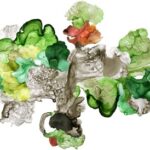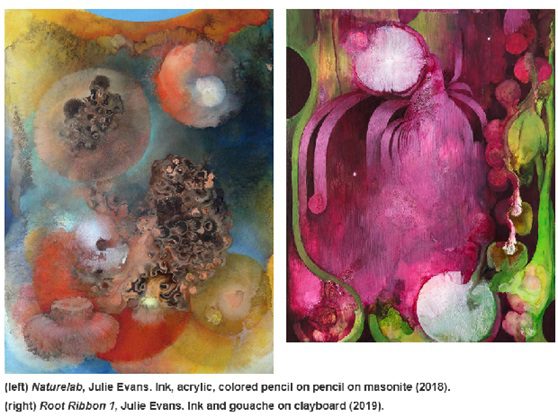 The Boca Raton Museum of Art presents the new exhibition Julie Evans: Eating Sunshine, on view June 12 – October 20. This is the first time the celebrated New York artist’s new ceramic sculptures are exhibited by a museum alongside her paintings.
The Boca Raton Museum of Art presents the new exhibition Julie Evans: Eating Sunshine, on view June 12 – October 20. This is the first time the celebrated New York artist’s new ceramic sculptures are exhibited by a museum alongside her paintings.
The timing of the exhibition “Eating Sunshine” coincides with the current cycle when our Sun’s magnetic poles prepare to reverse, and our planet is experiencing a peak period of solar activity.
What’s happening now is the most extravagant fireworks display in the entire solar system, as the increased magnetic energy of the Sun creates more solar flares and coronal mass ejections.
The title of the exhibition ‒ Eating Sunshine ‒ reflects the artist’s fascination with plants and organisms that need life energy and nourishment from the Sun to survive.
“While geared towards efficiency and survival, these interrelated systems of nature here on Earth and on our Sun share extraordinary power, logic, elegance, and beauty that is far beyond what we can see or understand,” says Julie Evans.
These sculptures are a recent, bold departure in her 30-year career, as Evans turns to ceramics to further explore her interest in the wonders of nature.
Eating Sunshine is curated by Kathleen Goncharov, the Senior Curator of the Museum, and features 48 works (24 ceramics shown together with 24 paintings, works on paper, and assemblages on mylar).
Both her two-dimensional and three-dimensional works radiate rich, saturated colors and ooze with biomorphic, organic forms.
Born in New York City, Julie Evans was one of the pioneers of the Chelsea art scene in the early 1990s. Decades later, Evans became part of the current wave of artists who have transformed upstate Hudson New York into an art destination, where her studio has thrived since 2011.
This is her first exhibition in South Florida. Throughout her career, Evans has been awarded several prominent residencies that have influenced her artmaking, including a Fulbright Scholarship to India, and creative fellowships to MacDowell, Yaddo, Ucross, Millay, and Tamarind Institute.
Her works are included in more than 300 public and private collections, including the Rubin Museum of Art, the United States Art in Embassies Program, and the Microsoft, JP Morgan-Chase, and Pfizer collections.
Kathleen Goncharov’s curatorial insights into the work of Julie Evans are the result of knowing the artist for more than 30 years.
They originally met in the early 1990s when they worked together at the New School in New York, and Goncharov has followed Evans’ artistic trajectory during the past three decades.
“Julie Evans finds inspiration in the structures and patterns of the materials from nature that she observes,” says Kathleen Goncharov, Senior Curator of the Boca Raton Museum of Art.
“Her works are imbued with penetrating colors and bold forms. Like nature, her art is both macro and micro, expansive and abstract, bursting with life in intricate detail. Evans’ intent is for the viewer to engage slowly and observe the incredible variety of forms, shapes, colors, and exquisite details found in her paintings and sculptures,” adds Kathleen Goncharov.
In her paintings and two-dimensional works, Evans teases nebulous forms out of poured pools of paint with arabesques curling in and out, as they reach outwards for the edges of the surface.
Some sections dissolve into the atmosphere that surrounds the shapes, between what is meant to appear to the eye as solid and what is not.
In contrast, her ceramic sculptures are totally singular, separated from the space around them.
As complete three-dimensional forms in and of themselves, the ceramics don’t rely on atmospheric support like the shapes in the paintings do.
Navigating this difference between her paintings and her sculptures, and getting to this point where they can both finally be shown together in a museum, is the central journey of this exhibition for Evans.
The artist is also known for the quality of detail in her work. During a 15-year period, Evans traveled to India many times to study Indian miniature painting techniques.
This influenced the attention to detail that comes across in her art to this day.
The roots of the miniature painting tradition in India go back to the Buddhist Pala dynasty, from the 8th century until the end of the 11th century.
This painting technique is noted for the incredible amount of detail that artists encapsulate within each minutely small canvas frame. Historically, they are meant to be viewed by one person at a time, at a close distance.
Evans traveled to India in the 1990s and the 2000s. She was awarded an Artist’s Residency Fellowship to Sanskriti Kendra in New Delhi, in 1997.
Also, as part of the Fullbright Senior Research Grant for Painting she was awarded in 2003, Evans lived and worked as an artist in India and Nepal for eight months.
Below are two public domain images of Indian miniature paintings.
(left) Princess Padmavati, ca. 1765 (public domain image).
(right) Woman Holding Fireworks, ca. 19th century (public domain image).






















